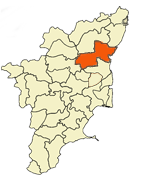
Tamilnadu - Tamilnadu Districts - Villupuram District Villupuram District
HistoryViluppuram District was earlier a part of Cuddalore District. It was then bifurcated from Cuddalore and became a separate district on 30th September 1993. Because of this, the history of Viluppuram district closely resembles that of Cuddalore. The Cholas were the early rulers. Among these rulers, Karikala Chola was the most famous and powerful. For a short period, the Cholas were overthrown by Simha Vishnu Pallava and the Region came under the Pallava rule for some time. Vijayalaya Chola again revived Chola rule. This was the beginning of great Chola Empire. The later Chola rulers were weak and the power passed on to the hands of Eastern Chalukyas. Cholas regained their lost position but with the rise of Jatavarman Sundara Pandya-1 (1251 A.D), Chola supremacy came to an end. The sway of Pandyas lasted for over 50 years, followed by Muslim domination from 1334 to 1378 A.D. By 1378, the region came under the rule of Vijayanagar Kingdom and Nayaks were appointed as the rulers of the region. In 1677 Shivaji took Ginjee area with the assistance of Golkonda forces, then after the Mughals came. During the Mughal regime, both the English and French acquired settlements in South Arcot. During the Anglo-French rivalry, the entire district was turned into a war land. After sometime, the entire area came under the control of East India Company. It remained under British authority till 1947 when India became independent.
Tourist places in Viluppuram* Gingee Fort * Kalvarayan Hills * Tiruvakarai Fossil Wood park * Anniyur Ramanatheeswarar temple * Sendamangalam Abath hayeswarar Temple * Parikal Narashimar Temple * Villupuram Anjaneyar temple(Fifty-five feet Anjaneyar statue near the temple tank, which is unique in Villupurum district) Visit the Colleges And Schools Around Viluppuram district Click here
|
|
